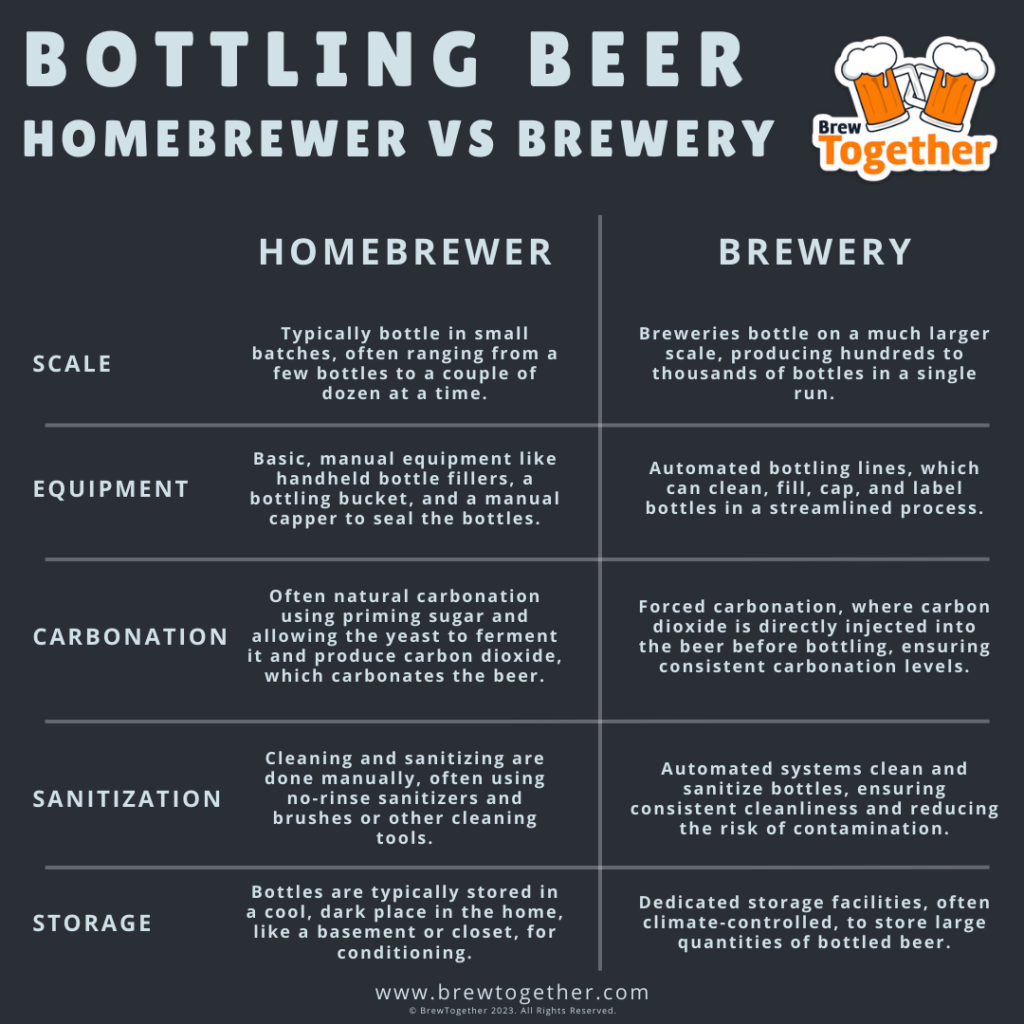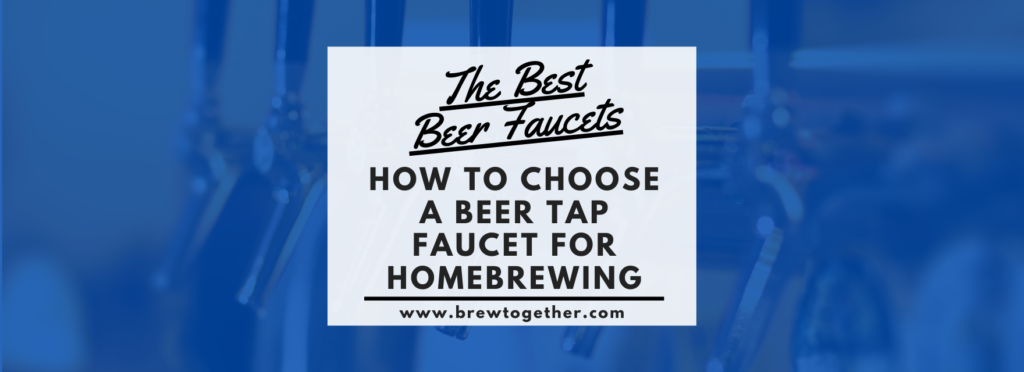The Best Beer Bottling Equipment for Homebrewing


The craft beer revolution and increase in the number of active homebrewers across the world has not only changed the way we think about beer but also how it’s packaged. Whether you’re kegging, bottling, or canning, having the right equipment plays a crucial role in ensuring that the beer’s quality and taste remain intact from brew day to glass.
Every step, from selecting the right grains to the final pour, plays a pivotal role in crafting that perfect pint. But there’s one stage that often doesn’t get the limelight it deserves: bottling. Whether you’re a commercial brewery distributing to thousands of paying customers or a homebrewer sharing your creations with friends, the right bottling equipment can make all the difference. It ensures that the beer’s taste, aroma, and carbonation are preserved, delivering the brewer’s vision straight to the glass. Let’s dive into beer bottling equipment, highlighting the best tools and machines for both large-scale commercial operations and homebrew setups. So, whether you’re looking to scale up your operations or just want to perfect your homebrew bottling process, this guide has got you covered.
Bottling Key Terminologies and Concepts
In the world of homebrewing, understanding the jargon is half the battle. Let’s break down some of the essential terms and concepts that every brewer, whether amateur or professional, should be familiar with:
- Bottle Filler: These are the workhorses of the bottling world. Bottle fillers are machines specifically designed to fill bottles with precision, ensuring that each bottle gets its fair share of beer without wastage or spillage.
- Stainless Steel: When it comes to bottling equipment, stainless steel is often the material of choice. Renowned for its durability and resistance to corrosion, it ensures that the beer remains uncontaminated, preserving its authentic taste and aroma.
- Bottle Cappers: Often overlooked, bottle cappers play a crucial role in the bottling process. They are responsible for sealing the bottles, ensuring that the beer inside remains fresh and free from external contaminants.
- Crown Caps: A staple in the beer bottling industry, crown bottle caps are the traditional sealing method for beer bottles. They provide a tight seal, ensuring the beer’s carbonation and freshness are locked in.
- Counter Pressure: This is a technique used in advanced bottling machines to maintain consistent carbonation levels. By controlling the pressure inside the bottle during the filling process, it ensures that the beer retains its desired fizziness.
- Automatic Control: Embracing modern technology, many bottling machines now come with automated controls. This not only speeds up the bottling process but also ensures a consistent fill level across all bottles, enhancing efficiency and reducing human error.
- Turnkey Solutions: For breweries looking for a hassle-free bottling process, turnkey beer filling machines are the answer. These are comprehensive systems provided by manufacturers that encompass every aspect of bottling, from filling to capping, offering a streamlined process.
- Oxygen Content: Last but certainly not least, oxygen content is a vital factor in the bottling process. Excessive oxygen within the bottle can adversely affect the beer’s taste and significantly reduce its shelf life. Modern bottling machines often come equipped with mechanisms to minimize oxygen exposure, ensuring the beer’s longevity and consistent flavor. For more information about how oxygen affects beer, check out our guide to how long beer lasts.
By understanding these key terms and concepts, brewers can make informed decisions, ensuring that their beer is bottled to perfection.
Homebrew Beer Bottling Process
Bottling beer is a crucial phase in the homebrewing journey, ensuring that the flavors and aromas developed during brewing are perfectly preserved. Let’s walk through the beer bottling process step by step. This process is a standard for homebrewers using priming sugar, however other devices, like those listed later in this article, allow for filling bottles from kegs under pressure using CO2. If you’re a homebrewer who is unsure about bottling vs kegging, check out our guide to the pros and cons of bottling vs kegging homebrew.
You can buy bottles suitable for homebrew in homebrew shops or online, but you can also reuse crown cap (pry off) bottles from commercial beer. Check out our guide to removing stubborn bottle labels if you go that route!
- Preparation: Before you begin, it’s essential to have all your equipment ready. This includes bottles, bottle fillers, caps, a capper, and, if you’re priming, sugar or carbonation drops.
- Cleaning and Sanitizing: The first and most crucial step is to thoroughly clean and sanitize the bottles and caps. Any contaminants can spoil the beer, affecting its taste and potentially making it unsafe to drink. While bottles can be cleaned and sanitized by hand, there are also bottle washers available that make the process faster and easier. We recommend Powdered Brewery Wash (PBW) for cleaning and Starsan for sanitizing.
- Priming (Optional): If you’re bottle conditioning your beer (carbonating it in the bottle), you’ll need to add priming sugar or carbonation drops to each bottle. This provides the yeast with a food source to produce carbon dioxide, which carbonates the beer.
- Filling: Using a bottle filler (like this one), fill each bottle with beer. The filler ensures a consistent amount in each bottle and minimizes the amount of oxygen introduced into the beer. Leave about an inch of space at the top of the bottle to allow for carbonation.
- Capping: Once the bottle is filled, it’s time to seal it. Place a cap on the bottle’s mouth and use a bottle capper to securely crimp the cap onto the bottle, ensuring an airtight seal. You’ll need a bottle capping system to cap the bottles. You can get a capping machine suitable for homebrewers on MoreBeer or Amazon for less than $20.
- Conditioning: If you’ve added priming sugar, the bottles need to be stored in a dark, cool place for a couple of weeks. This allows the yeast to consume the sugar and carbonate the beer. During this time, the flavors also meld and mature.
- Storage: Once conditioning is complete, store your bottles in a cool, dark place. This helps preserve the beer’s flavor and extends its shelf life. I you have extra space in a refrigerator, the beer will last even longer. Check out our guide to how long beer lasts in the refrigerator for more information!
- Enjoying: When you’re ready to enjoy your beer, refrigerate it for a few hours. Pour it into a glass, leaving any sediment at the bottom of the bottle, and savor the fruits of your labor!
Remember, the key to a successful bottling process is cleanliness and patience. By ensuring everything is sanitized and giving your beer the time it needs to carbonate and mature, you’ll be rewarded with a delicious, home-brewed beverage every time you open a bottle.
Bottling Beer: Homebrewer vs. Brewery
Bottling beer is a critical step in the brewing process, regardless of the scale. However, the methods and equipment used can vary significantly between homebrewing and commercial brewing. Let’s dive into the differences:


Homebrewer Bottling:
- Scale: Homebrewers typically bottle in small batches, often ranging from a few bottles to a couple of dozen at a time.
- Equipment: The equipment is more basic and manual. Homebrewers use handheld bottle fillers, a bottling bucket, and a manual capper to seal the bottles.
- Carbonation: Many homebrewers opt for natural carbonation using priming sugar. This involves adding sugar to the beer just before bottling, allowing the yeast to ferment it and produce carbon dioxide, which carbonates the beer.
- Sanitization: Cleaning and sanitizing are done manually, often using no-rinse sanitizers and brushes or other cleaning tools.
- Storage: Bottles are typically stored in a cool, dark place in the homebrewer’s residence, like a basement or closet, for conditioning.
Brewery Bottling:
- Scale: Breweries bottle on a much larger scale, producing hundreds to thousands of bottles in a single run.
- Equipment: Commercial breweries use automated bottling lines, which can clean, fill, cap, and label bottles in a streamlined process.
- Carbonation: Breweries often use forced carbonation, where carbon dioxide is directly injected into the beer before bottling, ensuring consistent carbonation levels.
- Sanitization: Automated systems clean and sanitize bottles, ensuring consistent cleanliness and reducing the risk of contamination.
- Storage: Breweries have dedicated storage facilities, often climate-controlled, to store large quantities of bottled beer.
Mobile Bottling Services
For breweries that don’t have their own bottling lines or need additional capacity, mobile bottling services or mobile canning services are a great solution. These are specialized companies that bring bottling equipment directly to the brewery. They offer a turnkey solution, handling everything from cleaning to capping, allowing breweries to bottle their beer without the overhead of owning and maintaining a bottling line.
While the end goal is the same – preserving the flavor and carbonation of the beer – the methods and equipment used by homebrewers and commercial breweries differ significantly. Whether you’re a homebrewer looking to scale up or a brewery considering mobile bottling services, understanding these differences can help streamline the bottling process and ensure the best quality beer.
How to Choose A Beer Bottling System
When diving into the world of beer bottling, selecting the right system can make all the difference in ensuring a smooth process and a high-quality end product. One of the primary considerations is production capacity. Before investing, it’s crucial to determine how many bottles you aim to fill within a specific timeframe. Whether you’re a small-scale brewer or a large commercial entity that requires a high quality, high efficiency beer bottle filling machine, there’s a machine tailored to your production needs.
Another vital aspect to consider is the bottle size and neck. Not all machines are compatible with every bottle type, so it’s essential to ensure that the system you choose aligns with your preferred bottle design. As for automation level, bottling systems come in manual, semi-automatic, and fully automatic variants. Your choice here will largely depend on your production scale and how hands-on you wish to be in the bottling process. Additionally, it’s worth noting that oxygen can be a beer’s worst enemy. Opting for machines that minimize oxygen content during bottling will help preserve the beer’s flavor and extend its shelf life. Lastly, while we all want the best quality, it’s essential to balance price and budget. While higher-end machines often offer more features and better quality control, there are cost-effective options available that don’t compromise too much on quality.
Commercial Bottling Systems
Commercial Systems are the titans, built for efficiency and consistency, catering to breweries with a wide distribution network. Here are a few recommended commercial-level bottle filling machines that offer high filling precision suitable for small breweries, craft brewers, and advanced homeberwers.
XpressFill XF4500
The XpressFill XF4500 is a counter-pressure beverage filler specifically designed to fill bottles with pre-carbonated beverages without compromising the carbonation levels. This is achieved through a high-tech sensor probe that consistently stops the fill at the ideal height in the bottle neck, ensuring uniformity regardless of slight bottle variations. While its primary design caters to carbonated beverages, the XpressFill XF 4500 is versatile enough to handle still products, provided they are supplied via a lightly pressurized keg or pump. This means it’s not only suitable for regular bottling but also for special bottle-conditioned beers.
The machine is also apt for filling Charmat-style sparkling wines, operating at a maximum pressure of 60 psi. To function, the XF4500 necessitates an air compressor to secure the bottle rest, a CO2 canister for pressurization and carbonation, and a pressurized container to facilitate the flow of the product through the machine. It can accommodate bottles up to 4 inches in diameter and 13.5 inches tall, covering most standard-sized 12 oz, 22 oz, and 750 mL bottles. With a capacity of 400 bottles per hour (12 oz), the machine is built with FDA-certified materials for beverage flow, ensuring safety and compliance. The dimensions of the machine are 16 inches wide, 21 inches high, and 15.5 inches deep, and it weighs 40 lbs. Each unit is handcrafted to order in California, with an average lead time of about 3 weeks.
Medusa™ MultiHead Counter Pressure Bottle Filler (Gen 2)
The Medusa™ MultiHead Counter Pressure Bottle Filler | Gen 2 is a premium counter-pressure bottle filler tailored for both the smaller craft brewer and the dedicated homebrewer. Priced at $2,199.99, this device is designed to make bottling day faster and more efficient. The Medusa features four separate filling heads, each equipped with individual stainless steel 3-way control valves, allowing for rapid fill rates. It’s a one-person operation system where a single pressure relief valve (PRV) ensures equal backpressure on all heads, resulting in consistent flow rates without the need for adjustments. Individual purge valves on each fill head facilitate almost complete oxygen removal in a bottle, which is crucial for preserving the beer’s freshness over extended periods. The filler’s construction is primarily of 304 Stainless Steel, ensuring durability and longevity. The G2 Medusa Multihead Counter Pressure Bottle Filler is adaptable, with the ability to adjust height, back pressure, and fill speeds to cater to various bottle styles. This flexibility, combined with its robust design and features like the fully draining removable drip tray, makes it a top-tier choice for those looking to enhance their bottling process.


The Best Beer Bottling Systems for Homebrewing
Homebrew Systems, on the other hand, are the heart of the hobbyist, designed for personal or local distribution.
Boel iTap
The Boel iTap Counter Pressure Bottle Filler for Crown Cap Bottles is priced at $179.99. This device, developed by Boel Technologies, is a counter-pressure bottle filler that connects directly to a keg. Unlike handheld designs, the iTap can function as a dedicated draft faucet, allowing users to switch between pouring into pint glasses and filling beer bottles without the need for extensive cleaning and sanitizing. The iTap’s design ensures that the bottle neck is locked in place during filling, making the process quicker and almost hands-free.
Counter-pressure filling is essential for bottling carbonated drinks, as it enables the purging of oxygen from the bottle and then pressurizing it to maintain CO2 levels as the beer is transferred from the keg to the bottle. This process not only prevents the loss of carbonation but also extends the freshness of the beer by minimizing oxygen exposure during filling. The iTap is specifically designed for use with long neck crown cap beer bottles. A notable feature of the iTap is its ability to eliminate any contact between the beer and oxygen, ensuring that the beer remains fresh and carbonated. The device is user-friendly, allowing for easy and clean bottling without excessive foaming or mess. The iTap boasts a high-quality construction and comes with a 5-year manufacturer’s warranty, making it suitable for both commercial breweries and homebrewers.
We use Boel iTaps at BrewTogether and we LOVE them. Check out our full review here for more information about how they work and how they have stepped up our bottling game!
Tapcooler Counter Pressure Bottle Filler
The Tapcooler Counter Pressure Bottle Filler, available at $79.99, is a bottling device primarily designed for homebrewers. It facilitates the bottling of beer directly from forward-sealing beer faucets, ensuring that there’s minimal CO2 loss during the process. One of its main features is its capability to purge both the bottle and its headspace with CO2. This is crucial in reducing oxygen exposure, which can adversely affect the beer’s taste and shelf life, making it suitable for bottling for various purposes, including competitions or personal sharing.
The Tapcooler stands out due to its practical design and straightforward operation. Unlike many counter pressure fillers that might need separate liquid lines or intricate setups, this device can be directly inserted into any forward-sealing faucet, such as those from brands like Perlick, Intertap, or Nukatap. Once it’s connected to a CO2 source, it’s operational. The mechanism behind the Tapcooler is counter pressure filling, where the bottle is pressurized simultaneously as the carbonated beer is introduced, ensuring the beer retains its carbonation. The device also features a telescoping bottle connection tube, making it compatible with bottles of varying heights, from 4.5″ to 12.5″. Additionally, it has a push-button CO2 purge valve and an adjustable pressure relief valve, giving users the flexibility to manage the filling speed and foam. For those concerned about maintenance, the Tapcooler is designed for easy cleaning, with parts that can be disassembled after use. Importantly, all metal components that come into contact with the beer are made of 304 stainless steel, emphasizing durability and cleanliness.
MoreBeer Counter Pressure Bottle Filler
The Counter Pressure Bottle Filler is priced at $69.99 and is designed to set the standard for home beer bottling. This device employs a unique one-way valve and adjustable pressure relief, allowing users to bottle sediment-free homebrew with ease. If you’re someone who carbonates and stores your homebrew in kegs, this filler enables you to bottle beer directly from those kegs. A significant advantage of this method is that you’re bottling already carbonated, clear beer, ensuring there’s no sediment at the bottom of your bottles.
Counter pressure bottle filling is a method used by breweries to bottle beer. The bottle remains under pressure as the carbonated beer flows in, ensuring minimal loss of CO2 in the solution. This method contrasts with pouring beer into a pint glass, where CO2 erupts out, creating foam. The Counter Pressure Bottle Filler mimics a single filling head on a professional bottling line, ensuring a smooth and efficient bottling process. Two standout features of this model are its construction entirely from stainless steel and its design to flush and fill from the bottom of the bottle. This design ensures a more effective purging of oxygen and reduces foam during the filling process.
The Last Straw®
The Last Straw® Beer Bottle Filler, priced at $105.99, is designed to offer a seamless transition from keg to bottle, ensuring that homebrewers can bottle cold, carbonated beer directly from their kegs without compromising on carbonation or clarity. This bottle filler stands out for its ergonomic design, which not only facilitates one-handed operation but also doubles as a bucket hook, ensuring that the filler remains off unsanitary surfaces between fills. The device is quick to set up and can be disassembled in seconds, making cleaning a breeze. All components that come into contact with the beer are made of stainless steel or silicone, ensuring the purity of the brew. Additionally, it’s worth noting that the Last Straw® is designed to maintain the beer’s carbonation levels, allowing for sediment-free bottles with consistent carbonation. The package includes all necessary tubing and fittings. However, users will need two CO2 ports or a “y” splitter with an MFL shutoff valve to use this bottle filler.
The Future of Beer Bottling: Embracing Cans and Sustainability
While technological advancements in the realm of bottling promise to elevate efficiency and the overall quality of the beer, the move from bottles to cans stands out as a defining change in the industry.
There are compelling reasons behind this transition to cans. From an environmental standpoint, cans emerge as a more sustainable choice. They are lighter, reducing transportation emissions, and are often more easily recycled than glass bottles. Beyond their eco-friendly attributes, cans offer practical advantages. They are adept at shielding beer from the detrimental effects of light, ensuring that the brew retains its intended flavor profile. Their portability makes them a favorite for outdoor events, picnics, and festivals. Moreover, the tight seal of a can often surpasses that of a bottle, minimizing the risk of oxygen contamination, which can adversely affect the beer’s taste.
Economically, the shift to canning is also driven by the bottom line. Canning lines, in many instances, present a more cost-effective solution for breweries. They not only tend to be less expensive initially but also occupy less space, allowing for more streamlined operations.
Consumer preferences are the final piece of this evolving puzzle. With a growing demand for craft beer in cans, breweries are not just responding to a trend but are actively shaping the future of beer packaging. This shift underscores a broader movement in the industry towards sustainable and eco-friendly practices, reflecting a world where consumers are increasingly conscious of their environmental footprint.
In essence, while bottles may never disappear entirely from the beer scene, the future seems to be tilting in favor of cans. As breweries continue to innovate and adapt, it’s an exciting time for beer enthusiasts and environmental advocates alike.
Thank you!
Beer bottling machines are pivotal in the brewing industry. As the craft beer revolution continues, investing in a quality machine ensures that the beer’s journey from the brewery to the consumer’s glass remains uncompromised. Cheers to that!
If you found this article was helpful, please share it with your friends using the social media share buttons below! We need your help getting the word out about BrewTogether!
Still have questions about beer filtration equipment or brewing your own beer? Leave a comment below or post in the forums! The BrewTogether Community is made up of an awesome group of homebrewers around the world. We are always supportive and happy to help answer your questions about brewing your perfect beer!
If you’re not a member of BrewTogether, we’d love for you to join! BrewTogether is completely free, and signing up is easy! Click here to join! We’d love to have you as a member of the BrewTogether Community!
Now using BrewTogether is easier than ever! Download the FREE BrewTogether Mobile App – available on both the Apple App Store and the Google Play Store! The BrewTogether App is completely free and drastically improves the experience of using BrewTogether on a mobile device.
Affiliate Disclosure: BrewTogether is a participant in the Amazon Services LLC Associates Program, an affiliate advertising program designed to provide a means for us to earn fees by linking to Amazon.com and affiliated sites. BrewTogether is also a participant in an affiliate program with MoreBeer, our favorite online homebrewing equipment/ingredients retailer. Some of the links in this article are affiliate links, which means that if you choose to make a purchase after clicking the link, I will earn a small commission at no additional cost to you. Please feel free to reach out with questions. Thank you for your support!











Responses